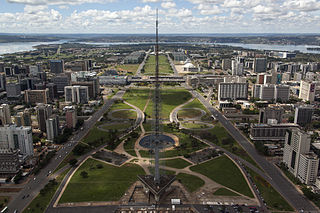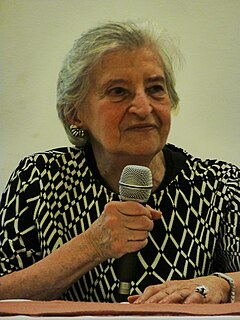
Urban design is the process of designing and shaping the physical features of cities, towns, and villages and planning for the provision of municipal services to residents and visitors. Although it deals with issues of a larger scale than architecture, it cannot be understood as a wholly separated field of research and design, since the quality of one depends on the quality of the other. In fact, it is this very interdependency, which has been termed relational design by Barcelona-based architect Enric Massip-Bosch, which makes urban design and architecture inextricably linked in many university education programs, especially in Europe. This tendency towards reintegration in architectural studies is also gaining momentum in the USA.

Landscape architecture is the design of outdoor areas, landmarks, and structures to achieve environmental, social-behavioural, or aesthetic outcomes. It involves the systematic design and general engineering of various structures for construction and human use, investigation of existing social, ecological, and soil conditions and processes in the landscape, and the design of other interventions that will produce desired outcomes. The scope of the profession is broad and can be subdivided into several sub-categories including professional or licensed landscape architects who are regulated by governmental agencies and possess the expertise to design a wide range of structures and landforms for human use; landscape design which is not a licensed profession; site planning; stormwater management; erosion control; environmental restoration; parks, recreation and urban planning; visual resource management; green infrastructure planning and provision; and private estate and residence landscape master planning and design; all at varying scales of design, planning and management. A practitioner in the profession of landscape architecture may be called a landscape architect, however in jurisdictions where professional licenses are required it is often only those who possess a landscape architect license who can be called a landscape architect.
Marjetica Potrč is an artist and architect based in Ljubljana, Slovenia. Potrč's interdisciplinary practice includes on-site projects, research, architectural case studies, and series of drawings. Her work documents and interprets contemporary architectural practices and the ways people live together.

Ian L. McHarg was a Scottish landscape architect and writer on regional planning using natural systems. McHarg was one of the most influential persons in the environmental movement who brought environmental concerns into broad public awareness and ecological planning methods into the mainstream of landscape architecture, city planning and public policy. He was the founder of the department of landscape architecture at the University of Pennsylvania in the United States. His 1969 book Design with Nature pioneered the concept of ecological planning. It continues to be one of the most widely celebrated books on landscape architecture and land-use planning. In this book, he set forth the basic concepts that were to develop later in geographic information systems.
Michael Robert Van Valkenburgh is an American landscape architect and educator. He has worked on a wide variety of projects in the United States, Canada, Korea, and France, including public parks, college campuses, sculpture gardens, city courtyards, corporate landscapes, private gardens, and urban master plans.

Sustainable landscape architecture is a category of sustainable design concerned with the planning and design of the built and natural environments.
Sauerbruch Hutton is an international agency for architecture, urban planning and design. It was founded in London in 1989 and is now based in Berlin, Germany. The practice is led by Matthias Sauerbruch, Louisa Hutton and Juan Lucas Young.

Stefano Boeri is an Italian architect and urban planner, born in Milan in 1956, founding partner of Stefano Boeri Architetti. He earned a master's degree in Architecture from Polytechnic University of Milan and a PhD in architecture in 1989 from Iuav University of Venice. Among the most known projects are the Vertical Forest in Milan, the Villa Méditerranée in Marseille, and the House of the Sea of La Maddalena.
Dr Timothy Beatley is an internationally recognized sustainable city researcher and author. His writings have focused on creative strategies cities can use to reduce their ecological footprints and become more livable and equitable places in the process. Beatley coined the term green urbanism and uses it frequently in his writings to describe the planning process used to create a sustainable city.
Ecological urbanism draws from ecology to inspire an urbanism that is more socially inclusive and sensitive to the environment. It is less ideologically driven, than green urbanism or sustainable urbanism. In many ways, ecological urbanism is an evolution of, and a critique of, Landscape Urbanism arguing for a more holistic approach to the design and management of cities. This type of urbanism has a central scope four main objectives, compactness, complexity, efficiency and stability. This model of Urbanism has as a goal to tackle the current challenges of society by intertwining sustainability and urban occupation models. The term appeared first in 1998 as "EcoUrbanism" in a book by Architect and Planner Miguel Ruano, who defined it as "the development of multi-dimensional sustainable human communities within harmonious and balanced built environments". The term was used later in April 2003 at a conference at the University of Oregon, and again in 2006 in a paper by Jeffrey Hou. The phrase was used by Mohsen Mostafavi in 2007 in Intervention Architecture and in a lecture at the Canadian Centre for Architecture, ecological urbanism as a project was largely started at Harvard University Graduate School of Design, with a conference, and exhibition, and book.
Kongjian Yu is a Chinese ecological urbanist, urban planner and landscape architect, professor of landscape architecture at Peking University (PKU) and the founder of the planning and design office Turenscape in Beijing.
The International Architecture Biennale Rotterdam (IABR) is a bi-annual international event bringing together international knowledge and experience in various design disciplines, and presenting this knowledge and experience to a broader audience.

Henrik Bjørn Valeur is a Danish architect-urbanist, founder and creative director of UiD (Denmark) and UiD Shanghai Co., Ltd (China), curator of CO-EVOLUTION: Danish/Chinese Collaboration on Sustainable Urban Development in China, which was awarded the Golden Lion at the Venice Biennale of Architecture in 2006, and author of the book India: the Urban Transition - a Case Study of Development Urbanism (2014), which is based on his experiences teaching, researching and practicing in India.
Sheila Kennedy is an American architect and professor at the Massachusetts Institute of Technology (MIT) who is known for including green technology, such as flexible solar cells, into her designs. She is interested in using technology in new ways and in re-examining traditional ways of building and designing structures.

Peter Daniel Alexander Jacobs is a Canadian landscape architect specializing in the conservation and development of rural and northern landscapes and in urban landscape design. He is Emeritus professor of the School of Planning and Landscape Architecture of the Universite de Montreal, Emeritus Chair of the Commission on Environmental Planning of the International Union for the conservation of nature (IUCN), Past President of the Canadian Society of Landscape Architects (CSLA), Chair of the Kativik Environmental Quality Commission and a Member of the Royal Canadian Academy of the Arts.
Carl Anthony is an American architect, regional planner, social justice activist, and author. He is the founder and co-director of Breakthrough Communities, a project dedicated to building multiracial leadership for sustainable communities in California and the rest of the nation. He is the former President of the Earth Island Institute, and is the co-founder and former executive director of its urban habitat program, one of the first environmental justice organizations to address race and class issues.

Felipe Correa is a New York-based architect, urbanist, author, and professor. He is the founder and managing partner of the design practice Somatic Collaborative. Correa is currently the Vincent and Eleanor Shea Professor and the Chair of Architecture at the University of Virginia School of Architecture. Previously, he served as faculty at Harvard Graduate School of Design as an assistant professor (2008-2012), associate professor (2012–2018), and as director of the Master of Architecture in Urban Design (MAUD) program (2009-2018). Correa's writing, research, and design work have been widely published and exhibited.
Nina-Marie Lister is graduate program director and associate professor in the School of Urban + Regional Planning at Ryerson University. From 2010-2014, she was a visiting associate professor of landscape architecture and urban planning at Harvard Graduate School of Design. Her career has spanned private and public-sector work, integrating science and policy with planning and design. As both a researcher and founding principal of PLANDFORM, a creative design practice, Lister focuses on the intersection of landscape infrastructure and ecological processes in metropolitan areas.

Rosa Grena Kliass is a Brazilian landscape architect. She is considered to be one of the most significant practicing designers in the history of modern and contemporary landscape architecture in Brazil. Her projects include the renovation of the Anhangabaú Valley, the Parque da Juventude, and the landscape master plan for the city of São Paulo do Maranhão. Kliass also founded and led the Brazilian Association of Landscape Architects in 1976.

Ana Maria Duran Calisto is an Ecuadorean architect, urbanist, and environmental planner who founded Estudio A0 with her husband and partner the architect Jaskran "Jazz" Kalirai in Quito, Ecuador.










